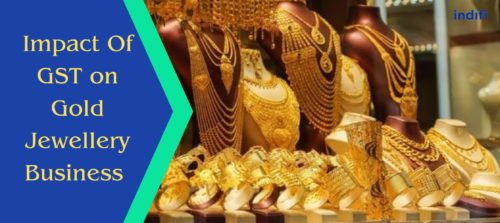
India adopted the goods and services tax on July 1, 2017, under the new tax system. That was a big adjustment to the nation’s tax structure. One must be aware about good GST and Bad GST. There were changes in many areas, but the gold jewellery business stood out. The GST on gold changed the way the industry operated, including prices, demand, and overall business performance. Let us now discuss how the GST gold rate has impacted the Indian gold jewellery business in a big way.
Understanding GST on Gold
India simplified its tax system by implementing the Goods and Services Tax (GST). This tax affected many areas, including gold jewellery. Now you can easily check status of GST Filing.
Understanding the GST of gold is essential to know how it affects the economy and markets in general.
GST Rates Applicable to Gold:
Gold and gold jewellery were subject to several secondary taxes before the GST. Value-Added Tax, Excise Tax Duty, and Customs Duty were some of them. The introduction of GST on gold led to a unified tax system. 3% was the GST rate for gold and gold jewellery. Also, there is a 5% charge for making gold jewellery. In reality, it makes buyers pay more GST overall.
Here is a breakdown of the GST rate of gold:
- GST on gold: 3% on the value of gold ( 1.5% CGST and 1.5% SGST)
- GST on making charges: 5%
These rates have replaced the previous complicated tax scheme. This makes the tax system easier to understand, but it also leads to some new problems.
Also Read :- Proven Strategies To Minimize GST Penalties.
Impact on Pricing and Demand of Gold
The GST on gold has significantly changed the gold jewellery market, affecting prices and buyer demand trends. Let’s examine how the new tax rates have changed how people buy things.
Increased Cost for Consumers:
Gold jewellery prices have generally increased due to the GST on the gold rate. Together, the 3% GST on gold jewellery and the 5% making charge have made the price of gold much higher for general buyers. This price increase has changed the minds of some price-conscious consumers, and their demand for gold purchases is decreasing. Here are few tips for ecommerce sellers to give better offers to customers.
The Shift in Consumer Behavior:
Before the GST rate for gold, people in India paid about 18% in taxes when they bought gold jewellery. Some of these were VAT, customs duty, and other fees. The GST has simplified this to a 3% tax on the supply of gold and a 5% tax on making charges. It brings down the tax rate to 8%. Due to this, consumers who compare and analyze it are feeling better with the reduction in taxes.
However, other market factors still significantly affect prices. Many people now like to buy gold during holidays or other special times. Also, there is a clear trend of buying gold trinkets with smaller weights to save money.
Impact on Medium and Small-Sized Businesses:
Small and medium-sized jewellery stores have suffered more than bigger ones from the GST on gold ornaments. These businesses have few profit margins, so the higher taxes have made it hard to stay competitive. GST registration, filing costs, and other rules have put even more pressure on their finances.
Impact on Market
The introduction of the GST rate of gold has changed the gold jewellery market. This has led to significant changes in how people act, and businesses work. Because of these factors, there is more formalization and a trend towards market players coming together.
Formalization of the Sector:
One good thing about GST for the gold jewellery industry is that it has made the business more official. Since the gold jewellery GST rate brought more businesses into the tax system, it has made the black market less common. Because of this, there is more openness and responsibility. Therefore, It’s good for both the business and the customers.
Competition and Consolidation:
Jewellers that are bigger and more financially stable have been able to adjust to the new gold GST rate rules better than smaller jewellers. Because of this, the business has more competition and growth. Big companies are getting a more significant piece of the market. In contrast, smaller jewellery stores are either closing down or joining bigger ones to stay in business.
Takeaway
Levying a GST on gold has dramatically affected the Indian gold jewellery business. Because of the new tax system, things are more precise and organised. But, it has significantly impacted the prices and demand in the market.
Adopting the new method has been especially challenging for small and medium-sized businesses. However, with the right financial help, businesses can deal with these problems and continue to do well in a competitive market.
Solutions like Indifi Technologies can be constructive for businesses struggling with the effects of GST for gold ornaments on their finances. Small businesses can get loans and customised financial services from Indifi. It can help them keep track of their cash flow and allocate funds to growth possibilities.
Indifi’s help can benefit small businesses trying to figure out how to deal with the difficulties that the GST for gold jewellery brings.
FAQs
- How much is the GST on gold jewellery right now?
In India, the GST on gold is 3% right now. Besides that, there is a 5% GST on the costs of making gold jewellery.
- What effects has GST had on Indian gold jewellery prices?
The price of gold jewellery has increased because of the 5% GST tax on manufacturing charges and the 3% GST on gold jewellery. This raises prices for buyers and lowers demand generally.
- What options exist for jewellers having trouble making ends meet because of GST?
Jewellery stores can get money from businesses like Indifi Technologies. They help people deal with higher taxes and invest in growth by giving them GST Business loans .
4. What is GST Composition Scheme?
The GST composition scheme is a tax-paying mechanism that is eligible for businesses having an annual turnover below ₹1.5 crore. It aims to effectively reduce the compliance costs and tax burdens of small businesses, by allowing them to pay GST at fixed rates instead of the value addition that occurs at each stage of their supply chain.



